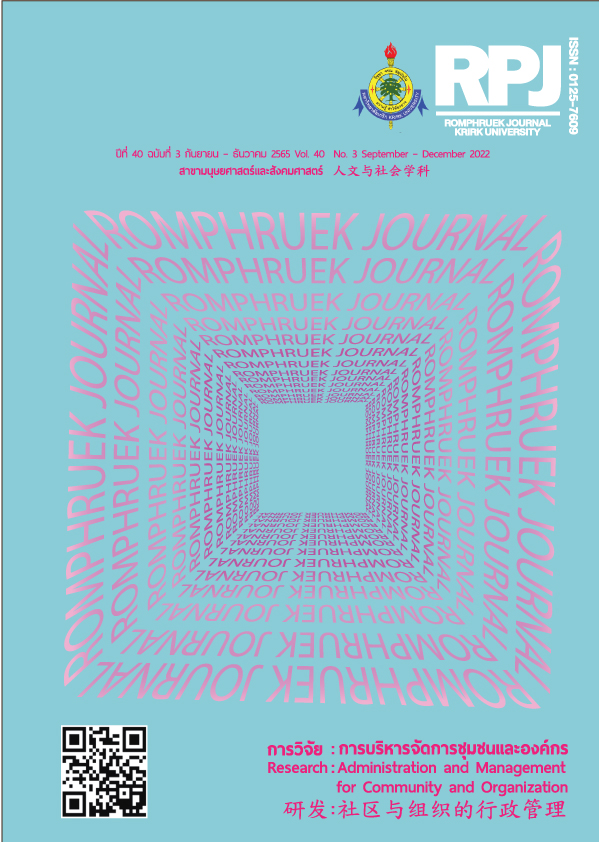Thai Spa Business Management Strategy towards Competitive Advantage
Main Article Content
Abstract
The research aims to: 1] develop a model of Thai spa business management strategy, 2] analyze the factors affecting spa business management, and to 3] analyze the guidelines for selecting strategies in managing Thai spa business towards sustainable competitive advantages. This was a mixed research methodology. The sample group was 400 customers who had used spa services in Bangkok by stratified random sampling. The key informants were nine personnel from the government officials, spa business experts and spa business entrepreneurs. Three personnel were selected from each group by purposive sampling. The tools were questionnaire and interview form. Quantitative data were analyzed by statistical methods. Qualitative data was analyzed by content analysis. The results showed that; 1] X2 is 105.45, X2/df is 1.622, CFI is 0.97, GFI is 0.98, AGFI is 1.00, RMSEA is 0.045. That is to say Thai spa business management strategy model towards sustainable competitive advantage was consistent with the empirical data. 2] Factors influencing Thai spa business management towards sustainable competitive advantages included: Entrepreneurs, Marketing Communication and Managerial Innovation. 3] Regarding the Thai spa business management strategy, the business entrepreneurs should use the strategies that respond to the customer needs in terms of quality and service.
Article Details

This work is licensed under a Creative Commons Attribution-NonCommercial-NoDerivatives 4.0 International License.
Every article published in the Romphruek Journal of the Humanities and Social Sciences is the opinion and point of view of the authors. Thery're not the viewpoint of Krirk University or the editored department. Any part or all of the articles for pablication must be clearly cited.
References
ฐิตาภรณ์ สินจรูญศักดิ์. (2550). การศึกษามูลค่าทางบัญชีและกำไรทางบัญชีในการอธิบายราคาหลักทรัพย์ ของกลุ่มอุตสาหกรรมบริการ ซึ่งจดทะเบียนในตลาดหลักทรัพย์แห่งประเทศไทย. วารสารวิจัยมหาวิทยาลัยเทคโนโลยีราชมงคลธัญบุรี, 10(2), 70 – 78.
บุญเลิศ เย็นคงคา และคณะ. (2549). การจัดการเชิงกลยุทธ์. กรุงเทพฯ : BK การพิมพ์.
ปฏิภาณ บัณฑุรัตน์. (2563). กลยุทธ์ทางการตลาดธุรกิจ สปาแบบองค์รวมเพื่อรองรับนักท่องเที่ยวชาวจีน. วารสารสวิทยาการมนุษยศาสตร์และสังคมศาสตร์, 3(2), 287 – 297.
พนิตสุภา ธรรมประมวล. (2550). ความสำเร็จทางการตลาดสำหรับน้ำสมุนไพรพร้อมดื่ม : กรณีศึกษากลุ่มแปรรูปน้ำสมุนไพรพร้อมดื่มในภาคกลางของประเทศไทย. กรุงเทพฯ : มหาวิทยาลัยรามคำแหง.
พิมพร ทองเมือง วิชากร เฮงษฎีกุ และ ฤๅเดช เกิดวิชัย. (2561). รูปแบบกลยุทธ์การตลาดของธุรกิจสปาเพื่อสุขภาพในสถาบันอุดมศึกษาประเทศไทย. วารสารวิจัยและพัฒนา มหาวิทยาลัยราชภัฎสวนสุนันทา, 10(2), 88 – 104.
วิทยา ด่านดำรงกุล. (2546). การบริหาร. กรุงเทพฯ : เธิร์ดเวฟ เอ็ดดูเคชั่น.
สุเนตรตรา จันทบุรี. (2559). โอกาสและความสามารถในการแข่งขันของธุรกิจสปาและนวดแผนไทย. วารสารเกษมบัณฑิต, 17(2), 49 – 63.
อรรถเดช สรสุชาติ. (2563). สถิติประยุกต์และระเบียบวิธีวิจัย. ขอนแก่น : กรีนเนสไวด์ จำกัด.
อภินันท์ อุดมศรี ประเพศ ไกรจันทร์ และ ทวีศักดิ์ รูปสิงห์. (2564). รูปแบบการพัฒนาสมรรถนะของผู้ประกอบการธุรกิจสปา. วารสารภาควิชาครุศาสตร์อุตสาหกรรม พระจอมเกล้าพระนครเหนือ, 12(1), 91 – 100.
Jarukit Marketeer. (2020). Spa-Massage : Market with ten thousand players and 1 other listed on the stock exchange. (March 25, 2021) Retrieved from https://marketeeronline.co/archives/.
Jay Barney. (1991). Firm resources and sustainable competitive advantage. Journal of Management. 17(1), 99 – 120.
Kline. (2016). Principles and practice of structural equation modeling. (3rded.). NY : The Guilford Press.
K. Pair. (2017). ระดับกลยุทธ์ การจัดการเชิงกลยุทธ์ (Strategy Level). (30 เมษายน 2565) สืบค้นจาก greedisgoods.com/ระดับกลยุทธ์-strategy-level/.
Schumacher, R. E., & Lomax, R. G. (2015). A Beginners Guide to Structural Equation Modeling : SEM. New Jersey : Lawrence Erlbaum Associates.
The Board of Investment of Thailand. (2014). Thailand 2013 Linking to Global Investment. (March 25,2021) Retrieved from https://www.boi.go.th/upload/content/Book_boi_2556final _15245.pdf.


